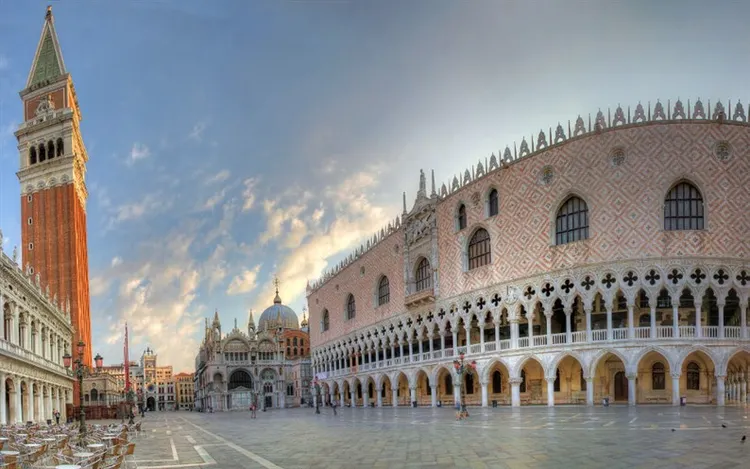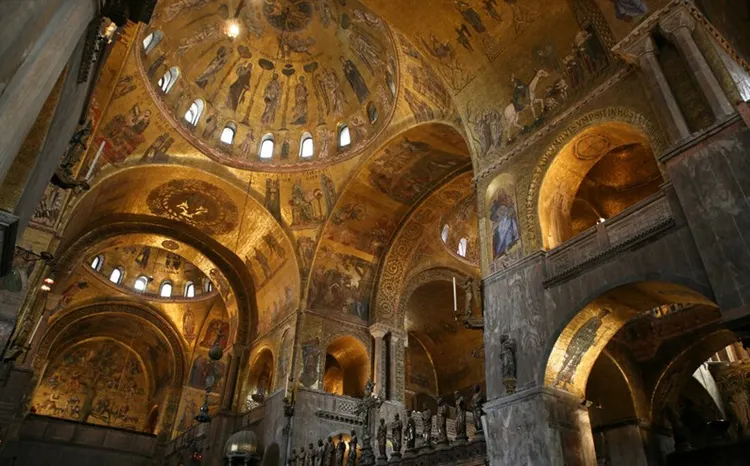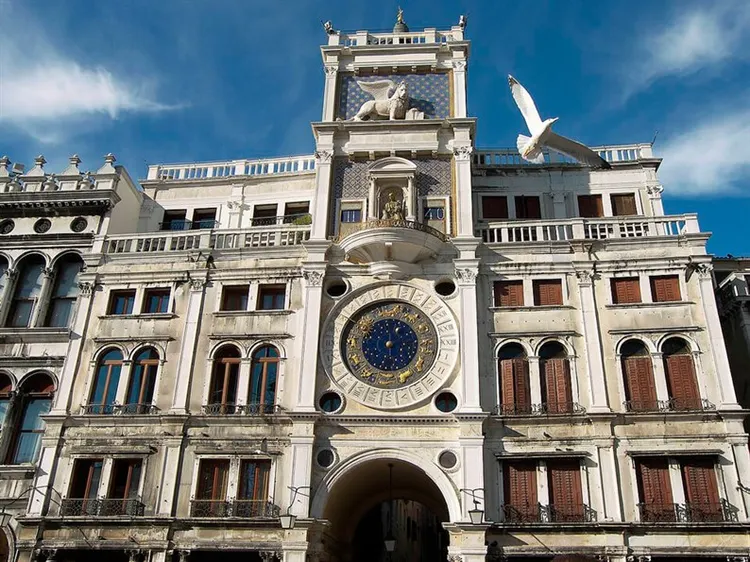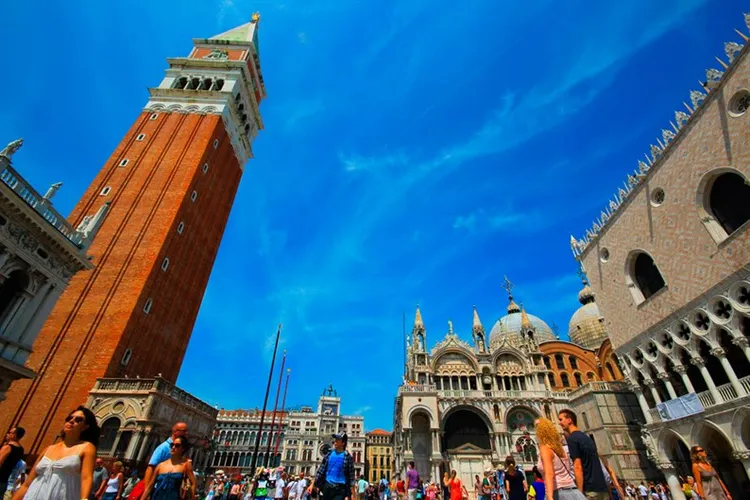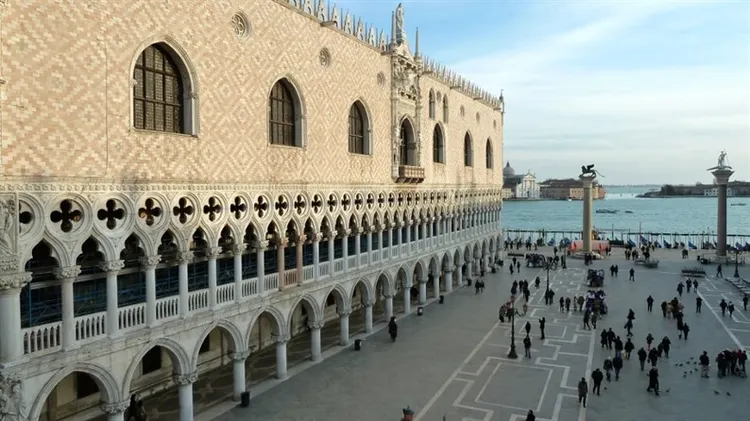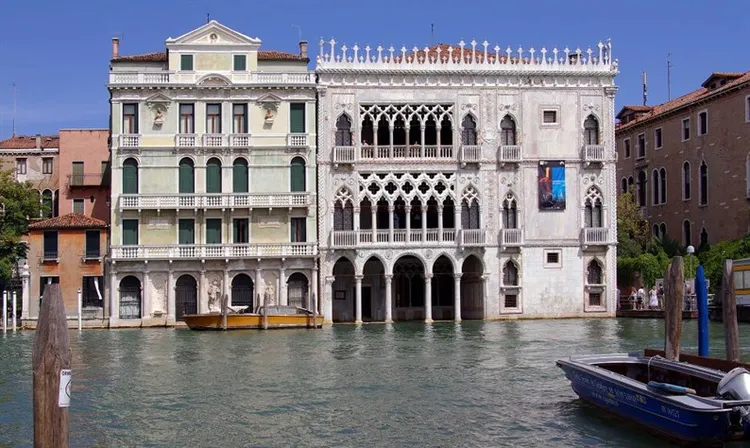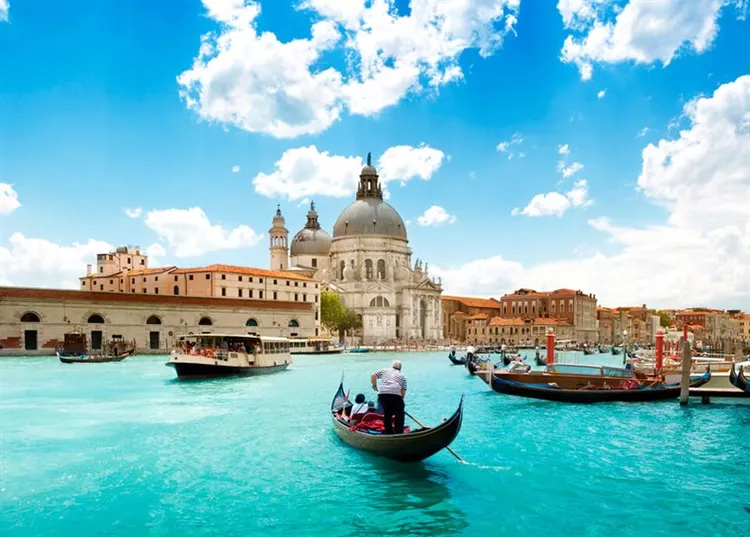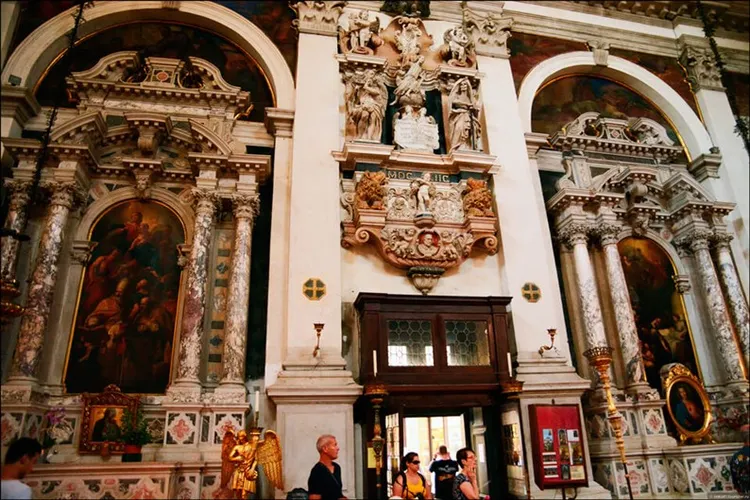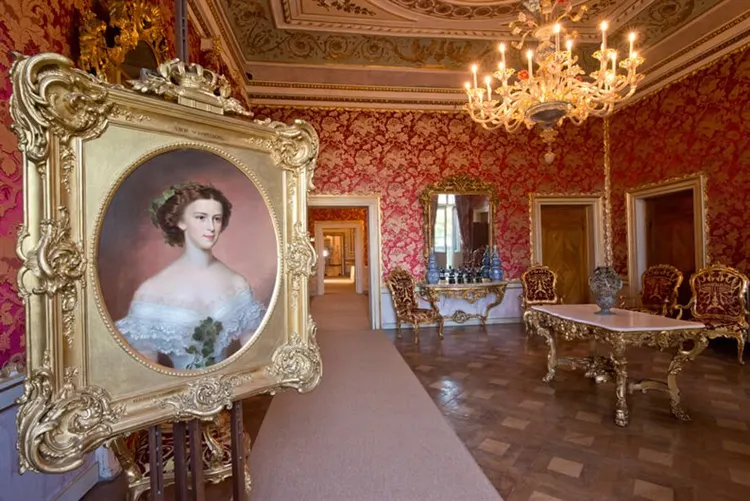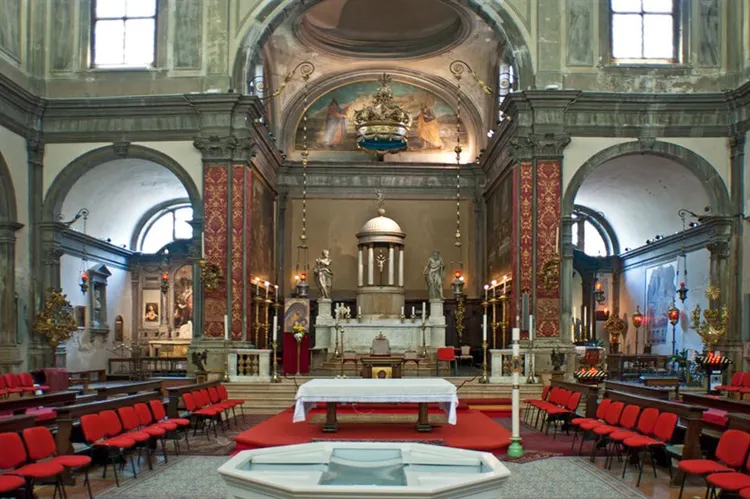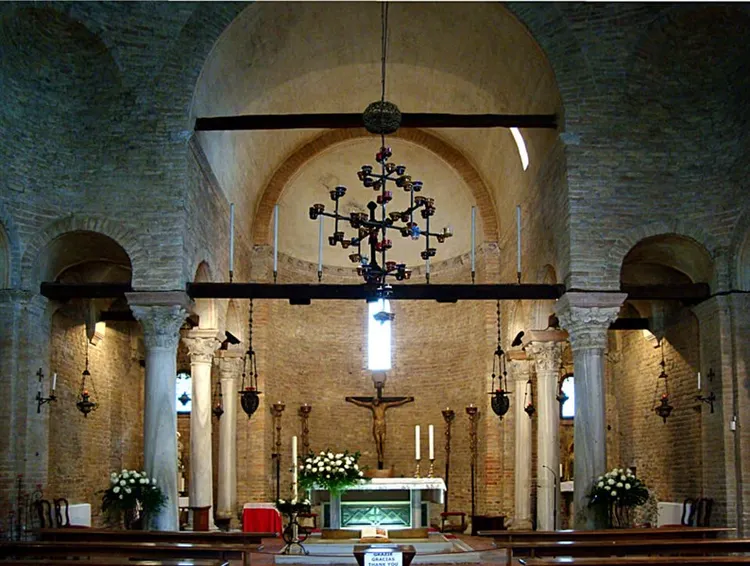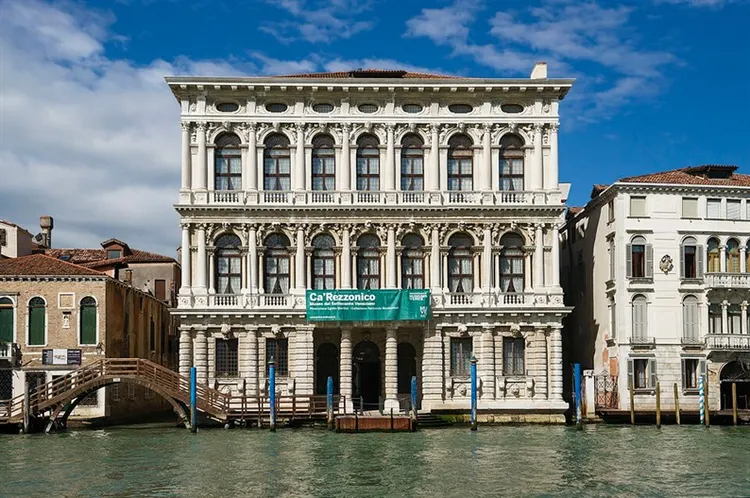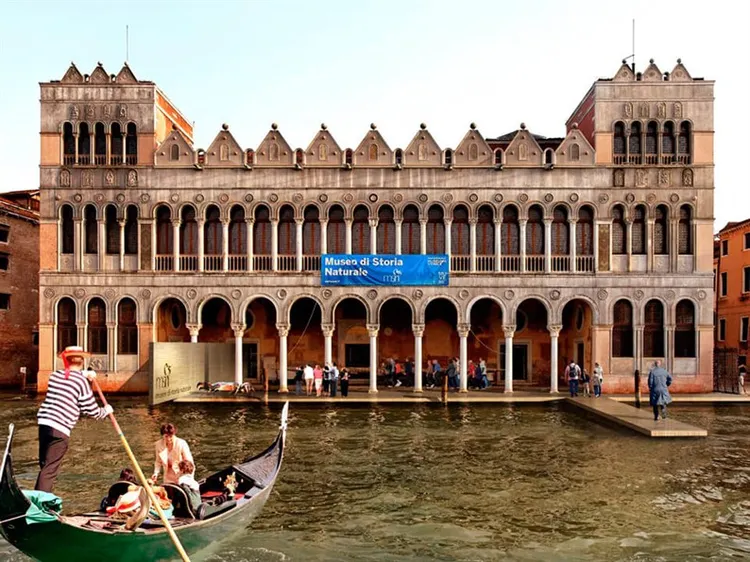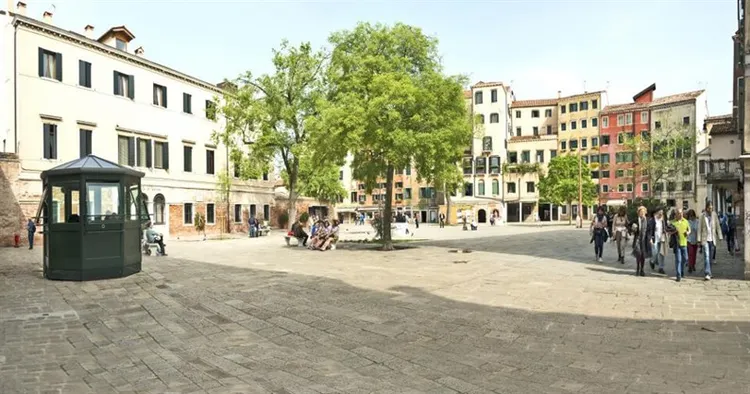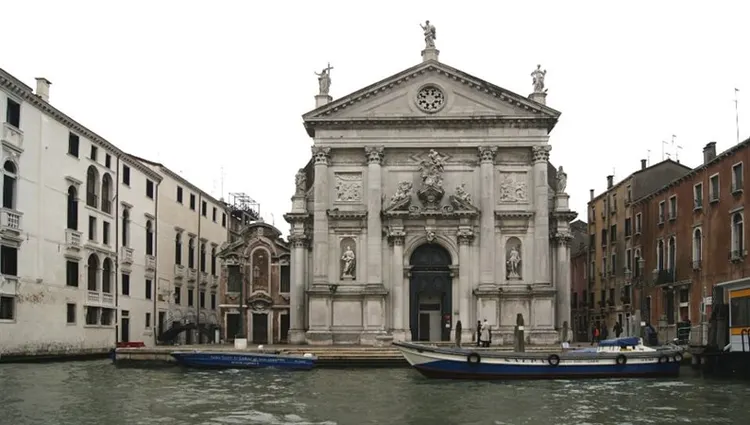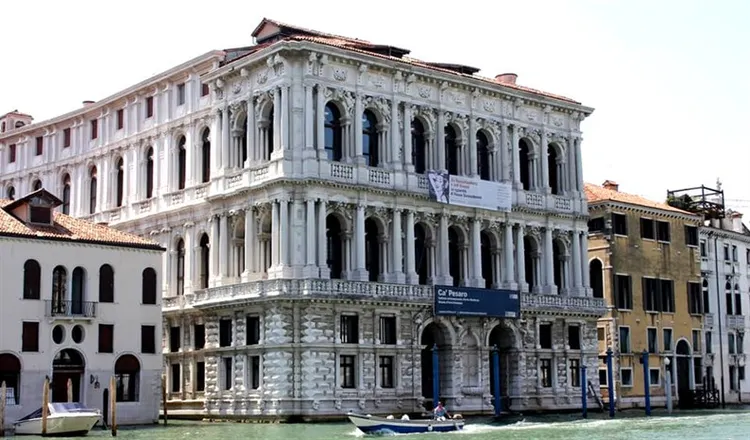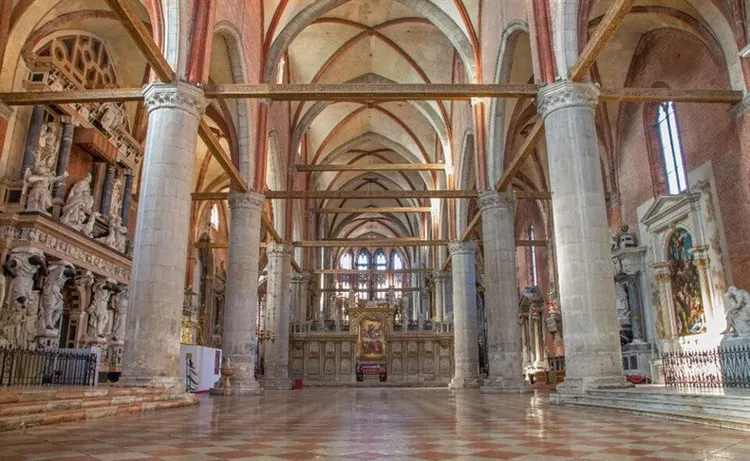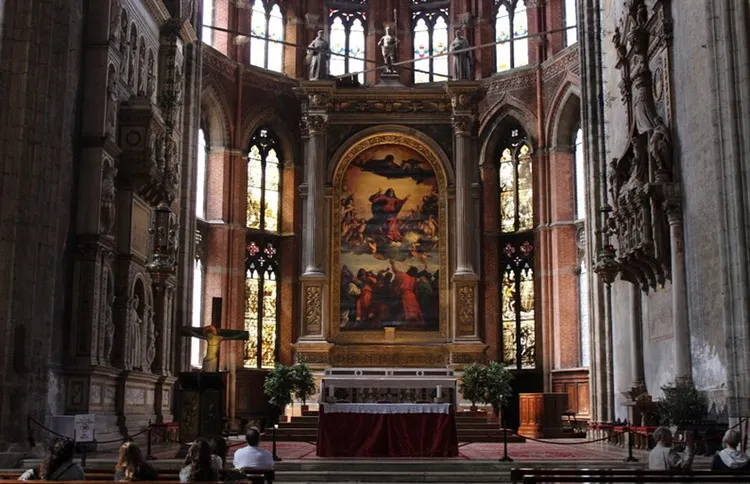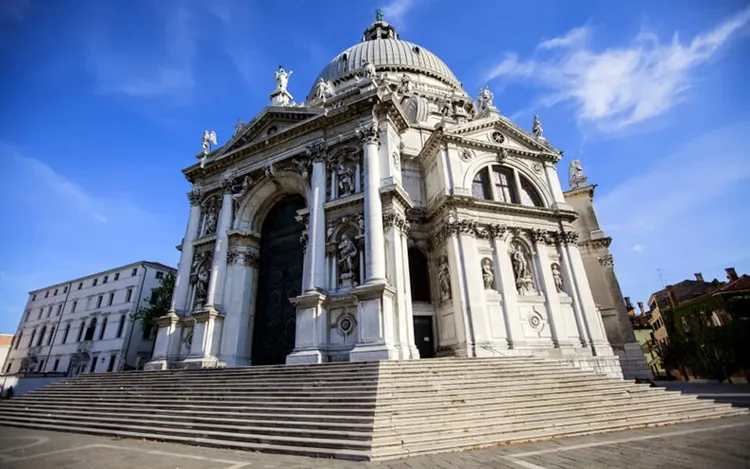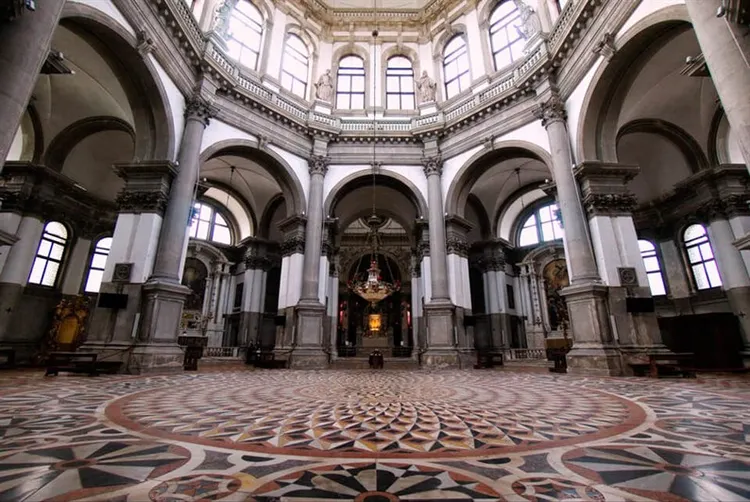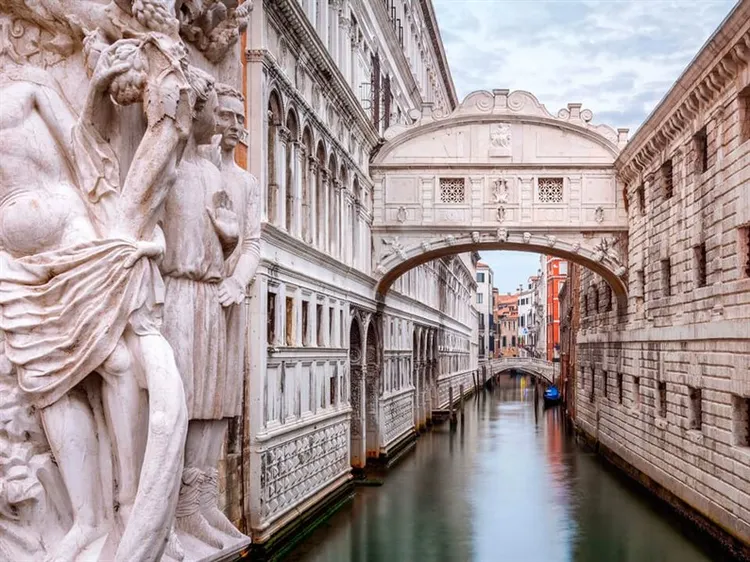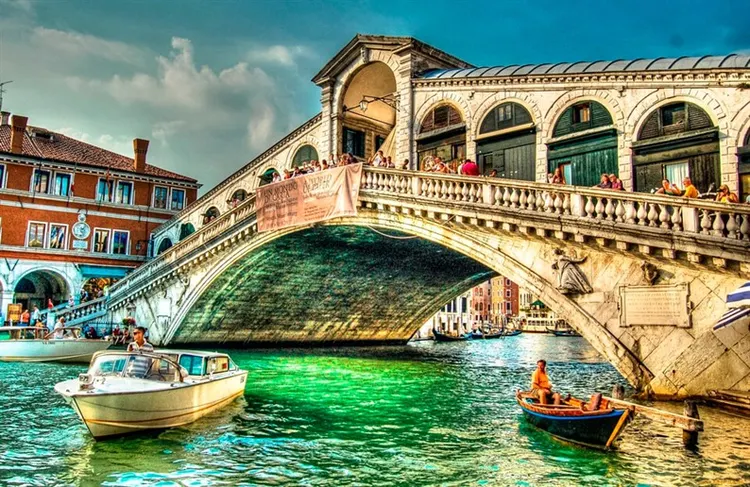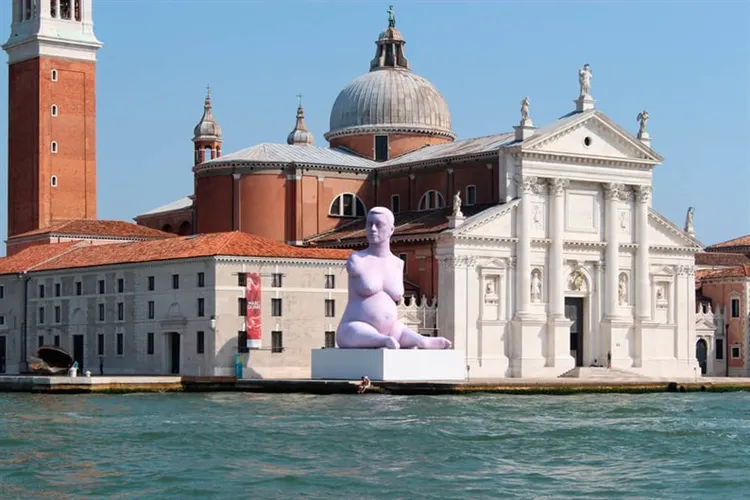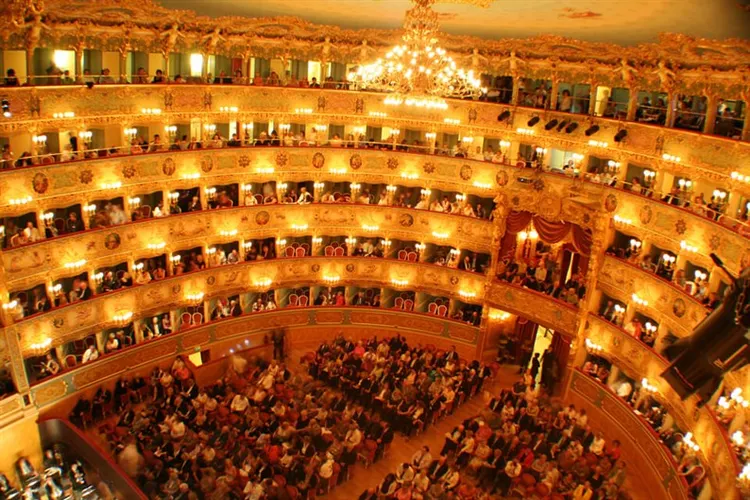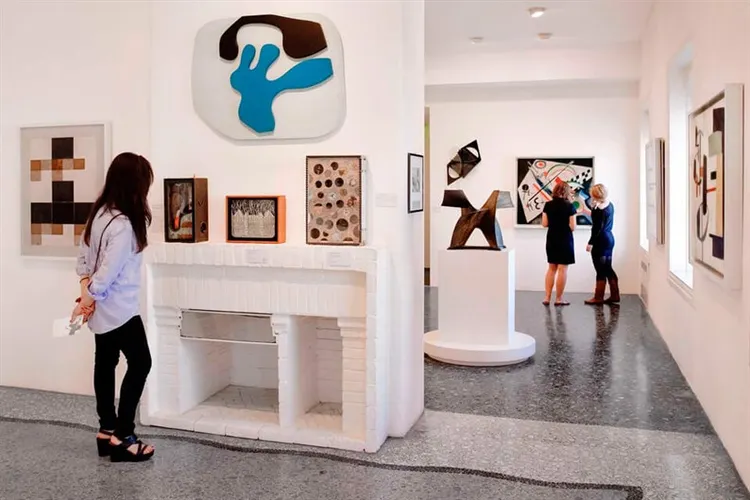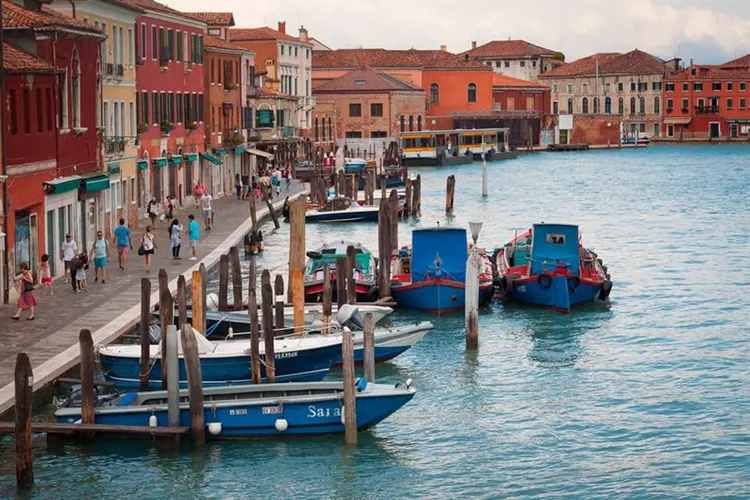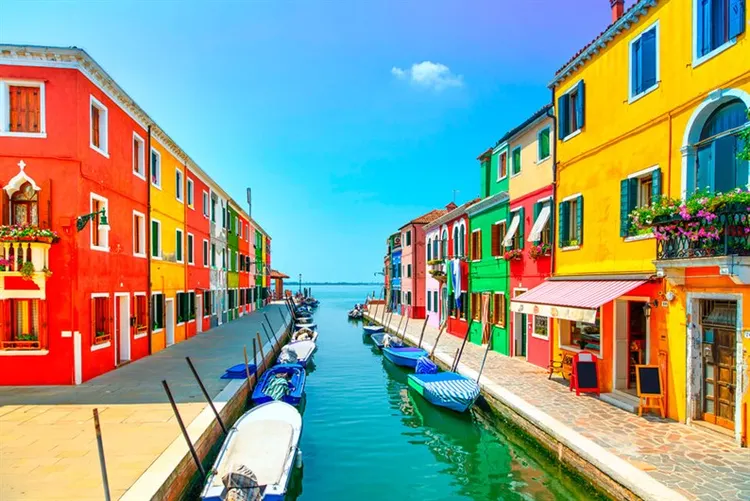What to see in Venice in 2 days – route, photo, description
Only in a dream or in a fairy tale can one see water channels instead of asphalt streets, along which sea vessels go instead of buses and trolleybuses. But such a miracle phenomenon exists in reality – the most unique city on Earth – beautiful Venice, amazing and unique, having seen it at least once, it is impossible to forget it ever.
1 day
If you have not made a list of objects at your discretion in advance, then we offer you to see the most significant Venetian sights. Reversing the famous proverb, we can say that “all canals in Venice lead from Piazza Roma”, connected to the Santa Lucia railway station by a graceful arc of the Calatrava Bridge. To save on transport costs, it would be optimal to purchase a travel subscription ticket (48 hours of travel – 30 €).
Piazza San Marco
The most famous city square of St. Mark is the “heart” of Venice, the same as Red Square for Moscow, so there are always crowds of tourists on it. You can get to it by vaporetto (river tram) along the N1 route from Roman Square along the main Grand Canal. It would not be superfluous to make a stop at the famous symbol of Venice – the ancient Rialto Bridge, walk along it to find yourself in the Middle Ages, then stroll through the market of the same name, full of bright colors, multilingual sounds and colorful smells. “Satiated” with first impressions, go to the stop. vaporetto N1 and continue towards the square. San Marco. Next stop – st. Valaresso with St. Mark's Basilica, where you will be amazed by the unique beauty of the gold altar.
Skip-the-line ticket to St. Mark's Basilica €5
Opera La Fenice: Skip-the-line ticket with audio guide €13
Short boat trip to Murano, Torcello and Burano €20
Gondola ride together €32
St. Mark's Cathedral
The temple of stunning beauty, where the relics of the great saint are kept, surpasses all the cathedrals of Europe in its exquisite architecture and external design. Despite repeated reconstructions and transformations, the cathedral building retained elements of the 11th century style. An amazing fact is that the majestic bulk of the temple is based on larch piles, which clearly confirms the unique strength of amazing wood.
All services are still held in the cathedral, if you wish, you can become a member of one of them. From the cathedral, you can walk directly to the square, surrounded by unsurpassed monuments of art and architecture: the famous Doge's Palace, Museums – Archeology, Correr, the majestic bell tower, the Marchiana National Library, etc.
Saint Mark's Clock Tower
In St. Mark's Square, numerous tourists are looking with interest at the clock tower of San Marco of the late 15th century, erected in the form of a quadrangular high pillar. Between the first and second floors in the center of the tower there is a monumental archway to the main street of Venice – Merceria and the old quarter of Rialto.
At the top of the tower, the sculptures of two Moors striking a bell with a hammer every hour, half an hour and 15 minutes attract attention. The young and old age of the Moors, captured in sculptures, is the personification of the passage of time in human life. Under the Moors on a blue star background is the symbol of the Evangelist St. Mark, who became the coat of arms of Venice – a sculpture of a winged lion holding an open Bible in its paws.
Below in the facade of the tower is a niche with a gilded sculpture of the Virgin and Child. The center of the tower attracts attention with the beauty and uniqueness of the large clock with a blue dial studded with gold stars, with the globe in the middle and figures of the zodiac signs arranged around the circumference.
Created 500 years ago, they still show hours and minutes, display the lunar phases, the time of year and the location of the sun to the zodiacal signs. It is possible to see how the mechanism of an old unique clock works during the tour. They are held 4 times a day with a set of 12 people: from Monday to Wednesday from 10:00 to 11:00, from Thursday to Sunday from 14:00 to 15:00.
St. Mark's Campanile
The tallest building in Venice – the Campanile of the famous St. Mark's Basilica rises to 99 meters in the square of the same name. It acquired its modern look at the beginning of the 16th century, adorned with a spire, completed with a weather vane with a golden angel and an attached open gallery – logetta.
The Campanile Bell Tower served for a long time as a beacon for ships and a watchtower. In addition, it was a place of punishment for clergy who were seen in same-sex relationships. In 1609, the bell tower became the site of Galileo's telescope testing.
Each of the five large bells on the campanile served its purpose, notifying the Venetians of the time and important events in the life of the city: the end and beginning of the working day, the onset of noon, the third – about the meetings of the Great Council and the Senate, gathered people before executions. From the height of the bell tower, a picturesque panorama of Venice and the Venetian lagoon appears. You can climb to the observation deck in October, November, May, June from 9.00 to 19.00, from December to April (until Easter) from 9.30 to 15.45 and from July to September from 9.00 to 21.00.
Doge's Palace
It is impossible not to admire the appearance of the majestic Doge's Palace, whose history is associated with the history of the emergence of the Venetian Republic (unification of 12 islands). The purpose of the luxurious palace is to accommodate 12 doges (representatives of the Senate).
This architectural masterpiece was built in the 15th century. on the site of the former (damaged by fire) and became a true gem among other architectural monuments of the past. But you cannot get a complete picture of the palace if you do not see it from the inside, where the design of each hall is striking in its luxurious beauty, an abundance of artistic masterpieces of painting and sculpture. What is worth only one Golden staircase, which is legendary!
After the tour, you can have a bite – there are a lot of cafes and cafes. If you can afford, you can go to institutions (Florian, Cuadri), glorified by the names of great artists who once were their regulars.
Snacks in them are more expensive, but the special atmosphere prevailing in everything will make you involved in the great history. A delicious, healthy lunch with seafood dishes and a glass of Venetian aperitif are waiting for you in one of the many trattoria restaurants. Having refreshed thoroughly, you can continue a romantic trip to the sights.
Ca'd'Oro Palace
It would be unforgivable not to see a unique architectural monument – the Ca' de' Oro Palace, otherwise called the “Golden House”, so you need to return to the stop. vaporetto N 1, take a boat and sail to the Cannaregio district. The light-colored building of an unusually beautiful design, Gothic architecture immediately catches the eye with an amazing elegant openwork of thin interlacing columns covering the loggias of the 2nd and 3rd floors.
As the story goes, huge funds were spent on the construction of this magnificent masterpiece: initially, the facade of the palace was decorated with gold leaf (for which it was nicknamed the golden house). Its owner M. Cantarini wished to make the palace (1430) a symbol of his power and wealth. The (presumably) famous artist of that time, the Frenchman J. Charlier, worked on the painting of the facade.
The beauty of architecture and the luxury of the decor of the building overshadowed all the noble buildings that existed before it, becoming the main decoration of Venice and remaining so until now, although there are no previous paintings on the facade.
Now inside the palace there is a museum of works of art, which include not only paintings, sculptures of the great geniuses of the past, but also elements of the design of the halls: magnificent mosaic floors, a carved marble well with elegant stone images symbolizing perseverance, mercy and justice. The impressions from visiting the masterpiece are so deep that it is worth slowly walking along New Street (to “digest” them) to the Ponte delle Guglie bridge, turn right 2 times from it and come to the iconic place of the city.
grand canal
The Grand Canal, which stretches for 4 km, curving the letter S through the historical center of Venice, is the main water street of the city. Starting near the railway station, it is like a guide to a fairy tale, opening to travelers a box with pearls scattered around the sides – multi-colored facades of medieval buildings, majestic temples and hundreds of luxurious palaces. There are no embankments on this unique street. All buildings built on piles have two exits – on land and on water.
Along the canal, palaces catch the eye with their stunning facades: Ca' Rezzonico – keeping the memory of Pope Clement XIII, Ca' Foscari – the residence of the former doges, Ca' d'Oro – an exquisite grand Venetian Gothic, Palazzo Barbarigo. A visual acquaintance with them makes you want to see the amazing palace interior and learn about their exciting history.
River trams run along the Grand Canal – “vaportetto”, river taxis and gondolas, mooring near four bridges: Scalzi, Rialto, Academy and Constitution, serving as a connecting thread with the main streets and squares.
Church of St. Moses
Not far from Piazza San Marco, the magnificent baroque facade of the Basilica of St. Moses with a brick campanile of the 14th century, a remarkable belfry with through arches, attracts the eye. The exterior with an abundance of statues and the interior design of the temple date back to 1682.
Two busts on the façade depict the Fini brothers, who invested in the reconstruction of the basilica. Their family crest is visible on the tympanum. The main place in the interior is occupied by a skillful altar with a relief composition depicting Moses with the Ten Commandments in his hands.
The chapel is decorated with paintings by famous Italian artists: The Last Supper by Tintoretto and The Washing of the Feet by Palma. The statue of Mount Sinai and the unique ancient organ attract attention. Many statues of saints and biblical characters decorated the interior of the church. The church is open on Tuesday from 11:00 to 18:00, Wednesday from 10:00 to 18:00, Thursday from 11:00 to 20:00, Friday from 9:00 to 19:00, Saturday from 10:00 to 20: 00, Sunday from 10:00 to 19:00. The entrance is free.
Correr Museum
The Correr Museum is named after the Venetian patrician Theodore Correr, who bequeathed his huge art collection and all the wealth to the city to create a museum. The collection received a residence permit in Piazza San Marco in the architectural complex of the Procurations. Palace halls are decorated with frescoes, pilasters, ornamental stucco and Venetian glass chandeliers. The halls on the ground floor display collections of old paintings, engravings, antique statues and sculptural compositions.
The history, culture and life of the Venetians are presented on the second floor. Here are exhibited collections of coats of arms, coins, medals, seals, a gallery of portraits of doges, models of ships and costumes of Venetians from different centuries. The art gallery is famous for paintings by Carpaccio, Bellini and the famous 13th-century panel by Lorenzo Veneziano depicting Jesus Christ surrounded by apostles and angels. The museum is open to visitors: from November to March from 10:00 to 17:00; from April to October from 10:00 to 19:00.
Church of the Holy Apostles
The place in the historic district of Canareggio, where the Basilica of the Holy Apostles stands, is considered the cradle of Venice. It was here that the people who founded the city first moored. Local tradition says that in the 9th century, Bishop Magnus had a vision about the request of the apostles to build a temple here, which was done in the 10th century.
Today, the Church of the Holy Apostles appears in the form of the middle of the XVIII century. The lower part of the temple was erected in the Gothic style, from the second floor it was continued in the architecture of the early Renaissance. Next to the church rises a bell tower built in 1672 and an early Renaissance chapel with the tomb of the Doge of Venice, skillfully executed by Tullio Coducci.
The premises of the temple are decorated in two rows with pilasters, paintings and altars of the 18th century. Above one altar, Tiepollo's 1748 Communion of Saint Lucia draws the eye. The decoration of another altar is the painting of the end of the 16th century “The Birth of the Virgin Mary”. Between the altar and the nave, the paintings The Last Supper and The Fall of the Manna by Cima de Conegliano and Paolo Veronese are of interest. You can see the masterpieces of painting from Monday to Saturday from 8.30 to 12.00 and from 17.00 to 19.00, on Sunday from 16.00 to 19.00.
Church of Santa Fosca
The Basilica of Santa Fosca is one of the oldest Catholic churches in the historic district of Canareggio, built in honor of the Holy Great Martyr Fosca, who suffered for the Christian faith in the 3rd century. The construction of the Church of Santa Fosca in this area dates back to the 10th century. It should be distinguished from the small church of the same name on the island of Torcello in the Venetian lagoon, built earlier in the second half of the 9th century.
The Basilica of Santa Fosca stands on the banks of the canal, overlooking a small square with a monument to Paolo Sarpi, who fought the Inquisition. Today, the temple appears in its appearance, formed in the first half of the 17th century with a neoclassical pink facade, decorated with four Corinthian pilasters, columns near the entrance and three statues of saints on the roof.
According to the architectural design, the Basilica of Santa Fosca is a single-nave building, completed with a dome, on which the date 1741 is visible. 2 side chapels and a square bell tower adjoin the main building. In the church interior, Tintoretto's painting “The Holy Family with a Donor”, the painting “Trinity and Madonna”, created in the 17th century by Filippo Bianchi and artistically depicted by Francesco Migliori in the 18th century, the life of St.
The church is open from Monday to Friday from 10.00 to 12.30.
Palace of Ca' Rezzonico
The magnificent white-stone palace, built in baroque architecture in the first half of the 18th century over the waters of the Grand Canal, bears the name of the first owner of the mansion Giambatista Rezzonico, the brother of Pope Clement XIII. The palace was built according to the designs of the best Venetian architects. Its interior is amazing with ceiling frescoes made by the famous painters Tiepolo and Canaletto, luxury of reliefs and ornaments on the walls.
Since the 30s of the last century, a museum of the 18th century has been opened in the halls of the palace. The first floor with carved mahogany furniture, porcelain, crystal chandeliers, clothing and accessories showcases the lifestyle of the Venetian nobility of the time.
The second floor is dedicated to unique views of Venice in the 18th century. Art lovers will enjoy the masterpieces of an extensive art gallery on the 3rd floor with a collection of sculptures, paintings by Piazetto, Tintoretto, Guardi and many famous artists, a large collection of ancient sculptures. The richly decorated entrance to the museum from the water of the Grand Canal is unusual. The museum is open: from April to October from 10.00 to 18.00, from November to March from 10.00 to 17.00. Day off – Tuesday, December 25, January 1 and May 1.
Museum of Natural History
In the water of the Grand Canal, as if in a mirror, the luxurious building of the Museum of Natural History, the mansion of Fondaco dei Turchi, is reflected. It was erected in the first half of the 13th century on the model of the palaces of the Constantinople nobility with the addition of Venetian color in the decor.
The palace halls occupy 2 million exhibits representing botanical, zoological, entomological and ethnographic museum collections. Expositions demonstrating ancient flora and fauna amaze with the appearance of skeletons and stuffed animals of extinct species of birds, animals, insects and fish. The pride of the exposition is the seven-meter prehistoric skeleton of Ouranosaurus, there are 50 million years old.
Extensive herbariums of plants from all continents and the Adriatic are collected in a separate room, a solid collection of minerals introduces the wealth of the earth's interior. The highlight of the museum is a grandiose aquarium that recreates the local ecosystem with invertebrates and fish living in it.
The ethnographic halls highlight the culture and life of the Venetians of different centuries. You can get acquainted with the unique expositions of the museum: Tuesday-Friday from June to October from 10.00 to 18.00, from November to May from 9.00 to 17.00; Saturday and Sunday from 10.00 to 18.00 all year round. The day off is Monday.
Venice ghetto
It is from the name of the historical district of Venice, where, at the direction of the Pope, from the beginning of the 16th century. baptized Jews lived, resettled from the island of Giudecca, the concept of “ghetto” was formed – a Jewish enclave, which took on an ominous meaning during the 2nd World War. 3 bridges, closed at night with gates, connected the ghetto with the city. Here you can see ancient synagogues, a slab with a threatening inscription against those who secretly consider themselves Jews.
It is impossible to pass by the expressive monument “Holocaust”. Many interesting things will open up in the expositions of the Museum of Jewish Art, allowing you to see how talented this people is. If you have no idea about kosher food, you can dine at a local kosher restaurant with moderate prices (15-20 €).
2 day
The second day of the trip around the city will also be full of strong impressions – the sights of the old Venetian district on Santa Croce will not leave anyone indifferent. For Venice, its eastern part plays an important role as a link with the mainland. At the Santa Lucia station, you need to take the vaporetto N 1, the already familiar route, and swim to the San Stae marina to see the beautiful church of the same name.
Church of San Stae
Even from the Grand Canal, you will see the amazingly beautiful white luxurious facade of the Baroque style and understand that in front of you is an architectural miracle that arose on this site in the 11th century. by Rossi. A church was erected in honor of St. Eustathius, to whom Jesus Christ allegedly appeared during a hunt. You can endlessly admire the graceful statues, columns with capitals, an openwork rose window, which became even more beautiful after the reconstruction of the 17th century.
The inner content of the temple, consisting of a stunning collection of priceless art paintings by famous Venetian painters of that era (17th century), will also cause complete delight. Tiepolo's The Torment of St. Bartholomew, Ricci's The Liberation of St. Peter from Prison, Piazzetta's St. James Led to the Place of Execution will touch you to the core – masterpieces that captured the tragic and bright moments of the life of great saints from the point of view of geniuses from art. Enriched spiritually and aesthetically, you can go further.
Palace of Ca'Pesaro
Near the church is the snow-white palace of Ca'Pesaro, an architectural monument of the 17th century. Baroque style, which is the best work of the talented architect B. Longen. The customers of the palace were the family of the noble family of Pesaro, who wanted to capture their wealth and power in this building.
Looking at a luxurious building with many thin columns, arched vaults with elegant sculptural decorations, with a relief decor on the 1st floor, you understand that huge funds have been invested here for good reason. The magnificent building of the palace now houses 2 museums – the 1st floor – the International Gallery of Modern Art, which exhibits the artistic masterpieces of Matisse, Chagall, Miro, Tanguy, Klimt, Kandinsky, Sironi, F. Malyavin.
On the 2nd floor there is the Museum of Oriental Art, where the expositions present the most interesting examples of objects of applied art from Japan, Indonesia, China, and India. The majestic picture of the beauty of Venice will not be complete without seeing another significant cathedral. To do this, you need to again take the vaporetto N 1 or N2, drive to the pier of Sao Toma and, focusing on the Frari sign, see the high tower of the grandiose church, and then the austere facade of the ancient pantheon temple (1250-1443) .
Cathedral of Santa Maria Glorioza dei Frari
The world-famous basilica is the burial place of famous personalities of Venice, including the brilliant painter Titian. Over the long years of construction, a monumental structure was erected, over which millennia have no power. Everyone who goes inside is shocked by the contrast between the external and internal appearance of the church, beautiful interiors, and extraordinary design.
A number of majestic columns lined with marble rush to the marble wall, covered with relief sculptural images, each of which carries a certain symbol and is an artistic masterpiece. An immeasurable feeling of admiration seizes everyone at the sight of the altar of Santa Maria – a real storehouse of works of religious art: statues of saints, unusual lamps, openwork lattice window decorations simply amaze with their beauty.
But the strongest impression is made by the central place of the altar, as if blazing with a bright flame – the painting of the great Titian “Assunta”.
On a grandiose (6.9 m high, 3.6 m wide) canvas, Mary is depicted in a scarlet dress, with her hands uplifted. Wide fluttering sleeves give the impression of wings, the saint “floats above the ground” surrounded by angels. The bright red triumphant tones of the picture symbolize the strength of the human spirit, its triumph over everyday earthly existence.
Other creations of fine arts masters of the 15th-16th centuries will also delight you, you will leave the cathedral as “enchanted wanderers”. But you won't be full of emotional and aesthetic impressions, you can think about lunch. Very close, on the square. Santa Margherita (Campo Santa Marqherita) a large selection of restaurants (trattoria and osteria) where you can have a delicious lunch.
An equally high-quality, but cheaper lunch will be offered at Pier Dickens Inn pizzeria-pub. After having a bite and resting, it is worth continuing the inspection, so that later you will not regret that you did not see another architectural monument, which is the church of Santa Maria della Salute, located in the same district.
Church of Santa Maria della Salute
This is another masterpiece of the 17th century. architect Longen, captivating the eye with external graceful beauty, was created in honor of the Mother of God after the end of the deadly plague, according to the oath to her (St. Mary) by the members of the Senate. Therefore, the view of the church is so fabulously beautiful that it is impossible to take your eyes off the snow-white walls, decorated with ornate openwork molding, from the divine sculptures installed in the niches and on the pediments, and in general from the whole amazing view of the temple.
It took 51 years to build this architectural miracle, which was opened after the death of its creator, the memory of which is honored by the grateful Venetians, proud of their brilliant fellow countryman and his unique brainchild, which, in general, looks like the best piece of jewelry. The interior design is in complete harmony with the exterior – elegance and beauty in everything. A magnificent mosaic floor, an openwork balustrade, wonderful paintings on the walls, unsurpassed art paintings by Titian.
The central altar, decorated by Longen himself, depicts the Madonna and Child, the symbolic figure of Venice and the diabolical image of the Plague, expelled by St. Mary. The expressive allegory and artistic mastery of execution leave no one indifferent, as do the images painted by L. Giordano, vividly conveying episodes of the life of Christ.
At the end of the trip, you should definitely take a gondola ride along the Giudecca Canal in order to fully soak up the enchanting atmosphere of the most extraordinary city on our planet. You can not rush to the place of lodging for the night – nimble boats maneuver through the channels around the clock.
Bridge of Sighs
The Bridge of Sighs over the Palace Canal, which delights tourists with its luxurious baroque style, is a romantic and mysterious place with a fascinating history that explains its name. The construction of the bridge was due to the need to connect the Doge's Palace, where justice was administered, with the prison, where, after the trial, criminals must be escorted to imprisonment.
For the construction of the woeful crossing, the project of the famous architect Antonio Conti was chosen with a roof and walls so that the criminal could not escape on his way to the dungeon. In 1602, the first convicts passed over the bridge, casting a farewell glance at the city, sighing for their lost freedom.
The world's most famous lover Casanova was once led across this bridge. Abstracting from the sad history of the Bridge of Sighs, it is impossible to hide admiration for its appearance with powerful arches and elaborate carvings on expensive snow-white marble. Today, the Bridge of Sighs has changed its dark reputation to a romantic one, gathering crowds of tourists and kissing lovers, confident that dreams come true here and love is strengthened forever.
Rialto Bridge
The Rialto Bridge, built in 1181 of wood, became the first crossing in Venice over the Grand Canal. Today, a stone bridge connects two tourist areas: San Marco and San Polo, opening the way to interesting sights – the Rialto Market and the Basilica of San Giacomo Rialto.
It was erected in the middle of the 16th century according to the project of the little-known architect Antonio de Ponte. The design of the Rialto was based on an inverted gondola. For the foundation of the bridge, 12,000 piles were driven in, on which there is a bridge 48 meters long, consisting of a gallery of 24 arches located on two sides.
The width of the arch, which serves for the passage of ships, is 28 meters, and the highest point reaches 7.5 meters. Rialto is decorated with white marble with bas-reliefs. The space between the arches is occupied by a series of shops and souvenir shops.
The center of the bridge is notable for a portico with two high arches, forming an observation deck that offers an amazing view of Venice. The Rialto Bridge has inspired artists and playwrights for centuries. How he looked in the 15th century is depicted in the painting by Carpaccio and described by Shakespeare's The Merchant of Venice.
Cathedral of San Giorgio Maggiore
The Benedictine church of San Giorgio Maggiore is one of the main attractions of the Venetian island of the same name. Its construction, begun in the second half of the 16th century by the outstanding Italian architect Palladio, was completed in 1610. The snow-white marble cathedral was built in the Renaissance style with a combination of a classic high nave with low side limits.
The temple is notable for the rare combination of two unique facades: with the presence of a wide pediment and a long architrave on one side and a narrow pediment and massive columns towering on pedestals on the other side. On the sides of the central portal are statues of saints – George and Stefan.
In the interior of the church, the altar is amazing, decorated with a sculptural composition depicting Jesus Christ on a ball supported by four apostles. The church interior delights with the luxury of decor and Tintoretto's paintings “The Last Supper” and “Manna from Heaven”, located near the presbytery. The cathedral bell tower, erected at the end of the 18th century, has 9 bells.
The campanile has an observation deck that can be reached by elevator to enjoy the picturesque landscapes of Venice and the lagoon with islands. The cathedral is open every day from April to October from 9.00 to 19.00, from November to March from 8.30 to 18.00. On Sundays, tourists are allowed to enter before the liturgy – 10.00 or after the liturgy from 14.00.
Teatro La Fenice
The building of the La Fenice Opera House was erected at the end of the 18th century on the site of the San Benedetto Theater, which burned down in a fire in 1774. The new theater was named La Fenice, which translates as Phoenix rising from the ashes. The theater building was built on the model of the Milanese La Scala opera, not yielding to it in luxurious decor and acoustics. According to the surviving drawings and drawings, they recreated the murals, decor on the balconies, walls and ceiling, admiring the richness of stucco and gilding.
From the opening day in 1792, operas by outstanding composers have been staged on the theater stage: Rossini, Bellini, Verdi. After a new reconstruction, the theater opened its doors in 2003. A visit to La Fenice is included in the program of many excursion tours, which allows you to see all the luxury of the interior and go behind the scenes. The theater has an exposition telling about its history from the day of its foundation and an exhibition dedicated to the opera diva Maria Callas. You can visit the theater on any day of the week from 9:30 to 18:00.
Peggy Guggenheim Collection
Palazzo Venier dei Leoni, which houses the Peggy Guggenheim Museum, is a one-story building skillfully decorated with snow-white Istrian stone. It looks exquisitely above the water of the Grand Canal and is notable for the bas-reliefs of 8 lion heads located along the lower line of the facade of the two side wings.
Inside the palace is a priceless collection of masterpieces of painting of the twentieth century, collected by the niece of the famous art collector Solomon Guggenheim. The museum exposition includes about 300 paintings by outstanding artists of the last century, demonstrating a palette of artistic styles: cubism, modernism, futurism and surrealism.
An unforgettable event in the life of connoisseurs of art is to see the original paintings by Léger, Kandinsky, Picasso, Malevich, Chagall and other artists whose work has entered the treasury of world art. Part of the collection is housed in the Nasher Sculpture Garden, which is impressive with sculptural expositions and installations by Moore, Caro and other masters. The founder of the museum, Peggy Guggenheim, is also buried in this garden. The museum is open daily except Tuesday from 10:00 to 18:00.
Murano Island
Murano Island is called an autonomous mini-city, uplifting with the iridescent colors of old residential buildings, the architecture of churches and palaces. This small island gained worldwide fame thanks to the art of local glassblowers, the secrets of which were kept secret for hundreds of years.
A unique palette of glass works of art and everyday life is collected at the Museum of Glass. It is impossible to resist the beauty of the original products of modern masters exhibited in the souvenir shops, so as not to take a memorable souvenir from the island.
It is impossible to ignore the ancient temples of Murano. The church of Santi Maria e Donato, preserved in the architecture of the 12th century, was erected in honor of the Virgin Mary revered by the Venetians and St. Donatus, whose relics were brought to the church in 1125.
The interior impresses with a mosaic floor depicting mythological animals and ornaments with vegetation. It is interesting to see the churches that existed in medieval monasteries: Santa Maria degli Angeli, restored in 1861, and Santa Maria degli Angeli, rebuilt after a fire at the beginning of the 16th century. From the center of Venice, there are several vaporettos from the San Marco Pier and the railway station to Murano Island.
Burano Island
The original and colorful island of Burano with a palette of colorful houses is cut through by blue ribbons of canals overlooking the waters of the Venetian lagoon. All the sights of this area of Venice are concentrated on Piazza Baldassare Galuppi. The falling bell tower of the Church of San Martino is striking here, the slope of which from the vertical has already reached 1800 cm due to the collapse of the soil.
The historical structure of the bell tower, built at the beginning of the 18th century, is decorated inside with frescoes by the famous painter Tiepolo. The Church of San Martino, erected in 1645 in the form of a Latin cross with a vaulted ceiling, two side and one main chapel, is famous for Tiepollo's painting “The Crucifixion”, recognized as a masterpiece of the Renaissance.
The island is famous for the art of lace making, passed down to lace makers from generation to generation. People from all over the world come to admire the original and rare examples of lace from the 16th to the 20th century at the Museo dei Marletti, located in the former school of lacemakers.
The products of old craftswomen and modern needlewomen placed on three museum floors are admired: collars, capes, napkins, tablecloths, church clothes, decorated with lace woven from silver and gold threads. The museum is open to visitors: in summer from 10:00 to 18:00, in winter from 10:00 to 17:00. Day off – Monday.
Which hotel in Venice to choose
If you are a wealthy person with a tight wallet and are not used to saving, you can stay in a respectable hotel right in the center, choose a room with a stunning view from the window (you will also have to pay extra for this) and indulge in exploring the “beauty on the water”.
And if your budget is much more modest, but Venice is your dream, you can find cheaper accommodation by staying in an inexpensive hotel in Mestre, separated from the object of desire by a narrow strait. In it you will be warmly welcomed, deliciously fed and given the opportunity to sleep well and “digest” the impressions and sensations of an unusual journey through the canal streets.
This will make your visit to the fabulous city even more romantic. It must be remembered that the main part of the path is connected with water, and from above it can spill in the form of rain, so it is better to put on comfortable waterproof shoes and put an umbrella in your bag.
